Getting to Know Sea Turtles
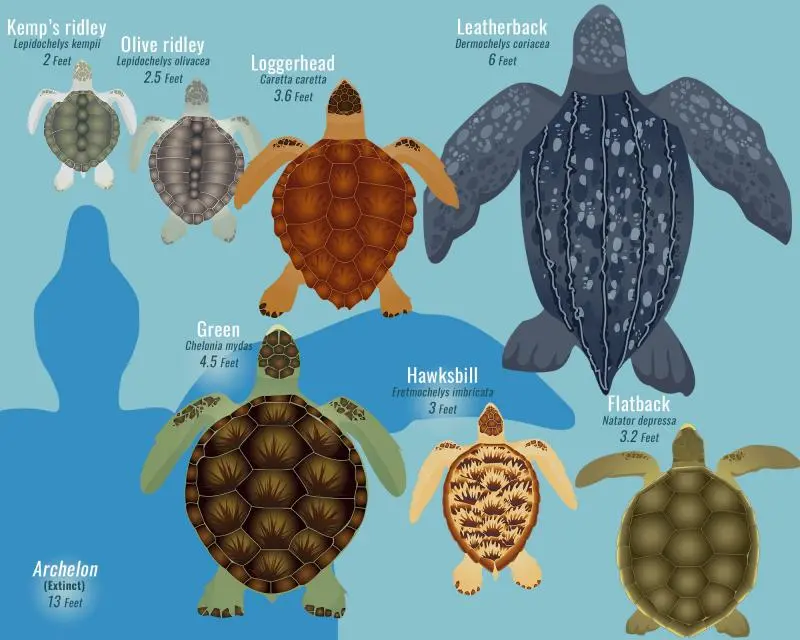
Types of Sea Turtles (Photo Credit : Smithsonian Institution)
All oceans are habitats for sea turtles, with the oldest turtle fossils being about 120 million years old, dating back to the Cretaceous period, meaning they are as old as the dinosaurs. These fossils have shown characteristics of modern turtles.
They have front limbs in the form of flippers that provide agility in swimming underwater. Generally, the front legs have only one claw, and a second claw is usually absent or very small. Male turtles can be distinguished from females by the size of the claws on their front legs and their relatively long tails.
Sea turtles are excellent swimmers and can swim as far as 4000 km. Although they spend most of their lives in water, they actually breathe with lungs, so they must surface to breathe.
They experience a varied nesting cycle, from once every 2 to 8 years. Male and female turtles spend their entire lives at sea, but females occasionally come ashore to lay eggs. The nesting cycle of turtles varies greatly, from 2 to 8 years. A female turtle lays hundreds of eggs in one nesting, but out of these hundreds of eggs, only about a dozen hatchlings (hatchlings) manage to make it back to the sea. The sex of the hatchlings from the hatched eggs depends on the environmental temperature where at a temperature range of 28-29°C, the sex will be female, and it will be male if the environmental temperature is below 28°C.
Scientific Classification of Sea Turtles
Kingdom : Animalia
Phylum : Chordata
Class : Sauropsida
Order : Testudinata
Suborder : Cryptodira
Superfamily : Chelonioidea
Habitat and Distribution
According to animal classification, sea turtles belong to the same class as reptiles, so sea turtles will lay eggs where these animals are hatched. Hawksbill turtles usually nest on sandy and pebbly beaches under the shade of trees, while green turtles, Kemp's ridley turtles, and leatherback turtles typically nest on wide, open beaches without tree shade. These turtles generally prefer quiet places to nest. Sea turtles are widely distributed animals that can migrate thousands of miles.

Map of Sea Turtle Conservation in Indonesia (Photo Credit : WWF)
Based on surveys of sea turtle nesting beaches conducted from 1997 to 2010 in various locations in the waters of the Riau Islands (islands around Kijang, Dabo Singkep, Sebangka, Natuna, Tarempa, Serasan, Tambelan), West Kalimantan (Paloh, Penambun), South Kalimantan (Denawan, Bira-Birahan, Samber Gelap), Bangka Belitung (Pesemut, Momperang, Kimar, P. Lima), South Sulawesi (Takabonerate), and West Papua (Jamursba Medi, Wermon, Mubrani, Ayau, Waigeo), hawksbill and green turtles are commonly found in the Riau Islands, West Kalimantan, South Kalimantan, Bangka Belitung, and South Sulawesi, while leatherback and kemp's ridley turtles are only found in West Kalimantan and West Papua. Among all species of turtles in Indonesia, the green turtle has the largest population.
Condition of Sea Turtles in Indonesia
Of the seven types of sea turtles in the world, only six are known to inhabit Indonesian waters: the leatherback, green, hawksbill, and kemp's ridley turtles, while the habitats for nesting of the loggerhead and flatback turtles are not known.
In some regions, sea turtle meat is consumed and used in traditional ceremonies, but nowadays, these practices have been abolished for conservation purposes.
In other areas, there is a tender system by the local government for the management of Sandy Beaches. In this tender, the winner is granted the right to collect and sell turtle eggs with the condition that 15% of these eggs must be hatched. In reality, tender holders often sell the eggs to cover the tender costs, resulting in the 15% hatching requirement not being met.
Global warming also impacts sea turtle reproduction, with rising earth temperatures (28-29°C) leading to the hatching of predominantly female turtles. Naturally, for the fertilization of one female, 4-6 male individuals are needed.
The Banyuwangi Sea Turtle Foundation (BSTF) in collaboration with the Veterinary Medicine Faculty at Airlangga University has created a Turtle Egg Incubation Box (Intan Box). Research with 50 turtle eggs incubated in the box at temperatures of 27.4-29.5°C over 56-64 days resulted in the successful hatching of 44 male hatchlings and 6 female hatchlings. The success rate of the Intan Box reaches 90%, compared to natural incubation in the wild.
Types of Sea Turtles
- Green Turtle (Chelonia mydas) IUCN: Endangered
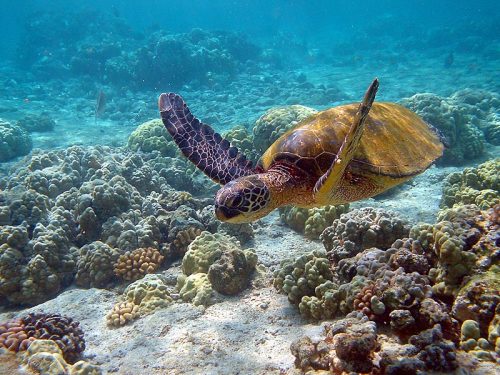
A Green Turtle (Photo Credit : Brocken Inaglory)
Scientific classification:
Kingdom : Animalia
Phylum : Chordata
Class : Reptilia
Order : Testudines
Family : Cheloniidae
Genus : Chelonia
Species : Chelonia mydas
The Green Turtle (Chelonia mydas) belongs to the Cheloniidae family. This type of turtle lives in all tropical and subtropical marine waters, especially in the Pacific and Atlantic Oceans. Adult green turtles are herbivores whose main diet consists of seaweed, and they inhabit coral reefs.
- Hawksbill Turtle (Eretmochelys imbricata), IUCN: Critically Endangered

A Hawksbill Turtle (Photo Credit : Hoffryan)
Scientific classification:
Kingdom : Animalia
Phylum : Chordata
Class : Reptilia
Order : Testudines
Family : Cheloniidae
Genus : Eretmochelys
Species : Eretmochelys imbricata
The Hawksbill Turtle is a species from the Cheloniidae family. This type of turtle is similar to other turtle species but is distinguished by its curved beak with a protruding upper lip and a shell that is serrated along the edges. The shell can change color depending on the water temperature it resides in. There are two subspecies of the hawksbill turtle; one found in the Atlantic and the other in the Pacific. E. imbricata imbricata is the subspecies in the Atlantic, while E. imbricata bissa is the subspecies in the Indo-Pacific region. Their diet consists mainly of sea sponges, and they inhabit coral reefs.
- Kemp's Ridley Turtle (Lepidochelys kempi)
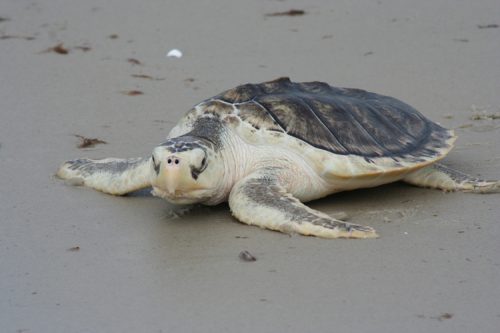
A Kemp's Ridley Turtle (Photo Credit : Kate Sampson)
Scientific classification:
Kingdom : Animalia
Phylum : Chordata
Class : Reptilia
Order : Testudines
Family : Cheloniidae
Genus : Lepidochelys
Species : Lepidochelys kempi
The Kemp’s Ridley Turtle (Lepidochelys kempi) is a species that lives only in the Atlantic waters and the Gulf of Mexico. Its diet includes sea algae, sea urchins, and sea algae.
- Olive Ridley Turtle (Lepidochelys olivacea) IUCN: Vulnerable
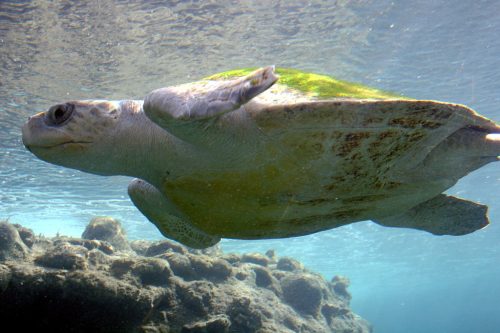
An Olive Ridley Turtle (Photo Credit : Thierry Caro)
Scientific classification:
Kingdom : Animalia
Phylum: Chordata
Class : Reptilia
Order : Testudines
Family : Cheloniidae
Genus : Lepidochelys
Species : Lepidochelys olivacea
The Olive Ridley Turtle is a species that can be found in the warm and tropical waters of the Atlantic, Pacific, and Indian Oceans. This turtle is smaller in size compared to other turtle species. The shell of an adult is olive-green to gray, and gray for its hatchlings.
- Leatherback Turtle (Dermochelys coriacea) IUCN: Critically Endangered
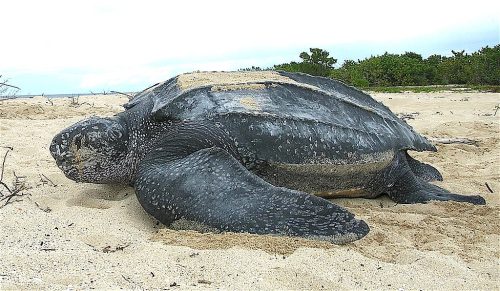
A Leatherback Turtle (Photo Credit : Albert Herring)
Scientific classification:
Kingdom : Animalia
Phylum : Chordata
Class : Reptilia
Order : Testudinata
Suborder : Cryptodira
Family : Dermochelyidae
Genus : Dermochelys
Species : Dermochelys coriacea
The Leatherback Turtle is a large species and is the only surviving member of the family Dermochelyidae. This turtle has a small, round, scaleless head, and its shell features a distinctive ridged pattern. Its diet consists of jellyfish and shrimp, and it lives in coral reef habitats.
- Flatback Turtle (Natator depressus), IUCN: Endangered
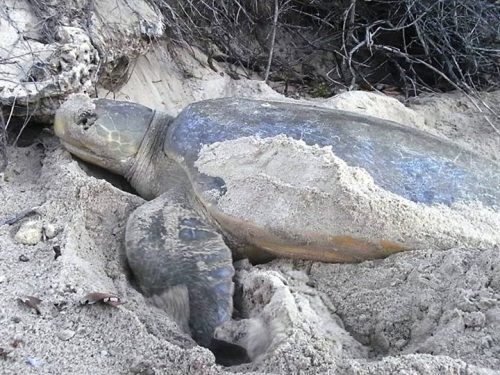
A Flatback Turtle (Photo Credit : Lyndie Malan)
Scientific classification:
Kingdom : Animalia
Phylum : Chordata
Class : Reptilia
Order : Testudinata
Family : Cheloniidae
Genus : Natator
Species : Natator depressus
The Flatback Turtle is a type of turtle that is endemic to the continental shelf waters of Australia. This species has a low, domed carapace with inverted edges, colored olive-gray, and a cream-colored plastron for adults. The hatchlings have a gray carapace with black-striped scales, with a plastron and edges that are white.
- Loggerhead Turtle (Caretta caretta), IUCN: Endangered
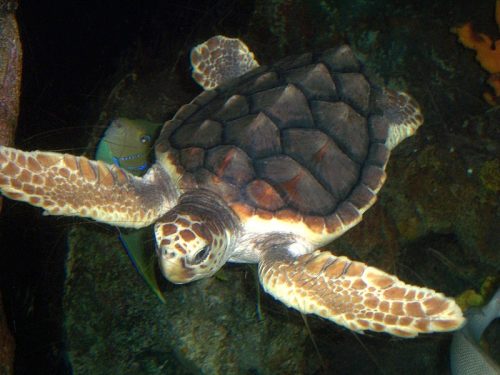
A Loggerhead Turtle (Photo Credit : Bachrach44)
The Loggerhead Turtle (Caretta caretta) is a type of turtle known for its hard carapace, which is reddish-brown or yellow-orange, featuring four pairs of coastal scutes and five vertebral scutes. The underside of the shell (plastron) is pale yellow. The upper side of the neck is brown, while the underside is yellow. The head of this turtle matches the color of its carapace, with two pairs of prefrontal scutes. Hatchlings are brown. The habitat and distribution of the Loggerhead Turtle are extensive, including the tropical and subtropical waters of the Atlantic, Indian, and Pacific Oceans, as well as the Mediterranean Sea.
-YN

